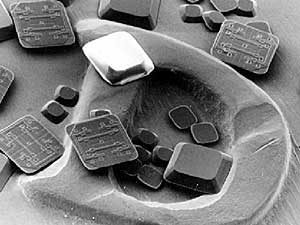| Banking on Biotech |
Audio
Photos
More from MPR
Resources
Respond to this story
| ||||||||||||||||||||||||||||||
North Dakota expects big things from nanotechnology
February 11, 2004
 |
| These computer chips are displayed on the "D" mint marking on the front of a dime. The image provides a sense of the challenges in manufacturing nanoscale products. (Photo courtesy NDSU) |
Fargo, N.D. — Nanotechnology is engineering on a molecular scale. It's about making products smaller, lighter, stronger and more precise.
The end result might be plastic that's flexible, yet strong as steel, or tiny sensors to monitor food for temperature or bacteria. The potential applications for nanotech are endless.
 | |||
In the basement of a science building on the North Dakota State University campus in Fargo, Dean Grier, assistant director of the Center for Nanoscale Science and Engineering, leads the way into a clean room. The clean room is designed to filter out dust particles that interfere with nanoscale manufacturing.
"The clean room was put in place for the sake of a program we are working with, a corporate partner named Alien Technology," says Grier.
The research in this room is already translating into jobs. NDSU's corporate partner, a company called Alien Technology, is building a manufacturing plant near campus. Alien will create 300 new jobs and anticipates expanding to 1,000 in 10 years.
Alien Technology is the world leader in radio frequency identification tags, known as RFID tags. The tags will soon start replacing the UPC code on consumer products. They'll hold more information and will be much easier to scan. Because they use radio frequencies, the tags can be scanned from a distance, and many can be scanned at the same time. The heart of the RFID tag is a tiny computer chip.
 | |||
"Some of the ones Alien is using are about .08 of a millimeter, or 800 microns, and when there's a vial full of them they look like pepper flakes," says Dean Grier.
The U.S. Department of Defense is already using the new generation of identification tags. Walmart will soon start using them.
Alien Technology expects to produce billions or trillions of the tags each year at its Fargo plant.
The company will anchor what North Dakota officials hope will be a cluster of nanotech businesses. Other companies might make the antenna for the tags, or the reader that gathers information from the RFID tags.
Alien Technology is in Fargo largely because of U.S. Sen. Byron Dorgan, D-N.D.. He steered more than $100 million in federal research contracts here in the past two years. That helped convince Alien Technology to move its production plant from California to Fargo.
 | |||
"Maybe we got a little lucky. Maybe we got a lot lucky in that Senator Dorgan has helped open the door for this opportunity for us," says Phil Boudjouk, vice president for Research, Creative Activities and Technology Transfer at NDSU.
Boudjouk says North Dakota has an opportunity to get in on the ground floor of an emerging industry.
"My approach right now, not that it wouldn't change, is to go for the low-hanging fruit. That is, you need to build up your track record and show you can do these things," says Boudjouk. "So, we wouldn't be swinging for the fences, so to speak. We'd be going for singles and doubles. And we know we have these."
NDSU is following a model that's been successful according to Phil Boudjouk. When research universities create useful technology, private industry will come calling.
The Red River Valley has a legitimate shot at becoming an attractive place for nanotech companies, according to Minneapolis-based nanotechnology consultant Jack Uldrich. The federal government is pouring money into nanotech research, says Uldrich, and North Dakota stands to benefit from Sen. Dorgan's ability to steer some of that money to his home state.
|
You need to build up your track record and show you can do these things. So, we wouldn't be swinging for the fences, so to speak. We'd be going for singles and doubles. And we know we have these.
- Phil Boudjouk, vice president for research at NDSU |
"It's extremely important, and I think Senator Dorgan is much more effective than Minnesota's two senators currently are," says Uldrich. "He's far more visionary than the average U.S. senator, and his efforts are going to pay real dividends for the Red River Valley region."
Newly created nanotech jobs will pay well, but demand a highly trained workforce with broad math and science skills, says Uldrich.
North Dakota officials aren't predicting how many jobs nanotech might bring to the region, but the potential applications for nanotech-related industries are enormous.
NDSU is using tiny computer chips to develop small, inexpensive sensors for the U.S. Department of Defense. They can be spread across a large area and gather and relay information about troop movements or biological weapons.
The tiny sensors also might soon tell you if your food is fresh, or alert a farmer to the first sign of crop disease.
Other researchers at NDSU is using nanotech to develop strong, flexible plastics, more durable computer hard drives and paint for the navy that will keep barnacles and bacteria from sticking to ships.
North Dakota officials are confident success will bring more federal research dollars, and more entrepreneurs to the Red River Valley.
|
News Headlines
|
Related Subjects
|

